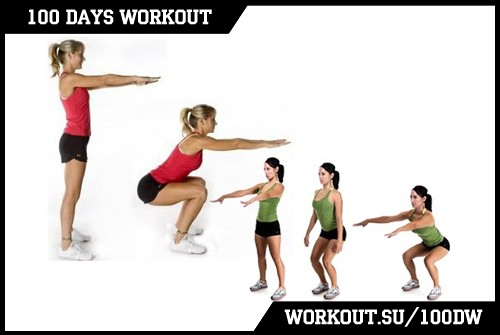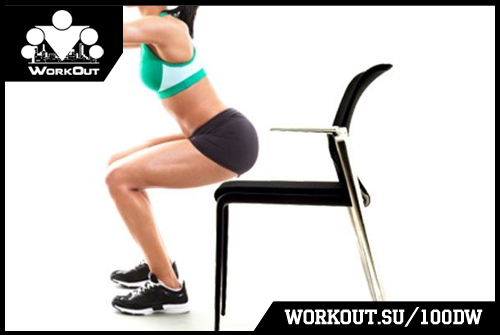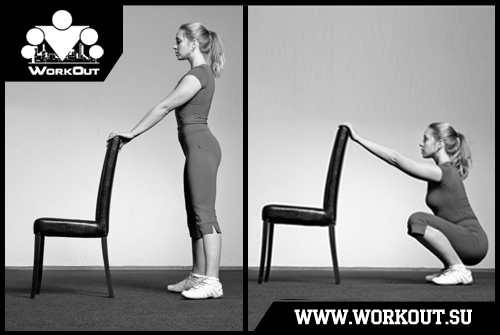That is no secret that those who are familiar to street workout love to do pull-ups, push-ups and different tricks on the bar. However, almost nobody of them like to squat. Nevertheless, squats are the most common and effective exercise for lower body that you can only imagine. So today we will speak about squats.
Squats
Squats are one of the most effective strength exercise, because squatting motion involves so many muscle groups all over the body. First of all, squats load your quadriceps (Musculus quadriceps femoris), butts (Gluteus maximus), adductor magnus muscles, muscules soleus. Hamstrings (Musculus biceps femoris) and gastrocnemius (Musculus gastrocnemius) run as stabilizators. These are main working muscles groups. But if you remember that you need to keep balance while squatting then we can name some more working muscle groups such as: abs, muscles of back and arms.
*** IMPORTANT ***:>
Squats may be very harmful for your knees and lower back if you do not use safe proper technique. So pay attention to the information below.</quote>
Key Moments
- The wider the range of motion the bigger the number of muscles involved
- Strain your abs, it will help to fixate your spine
- For best result you need to keep muscles tension during all range of motion
- Sit down slowly and stand up rapidly
- Breathe in while you moving down and breathe out while moving up
Exercise Overview
While squatting involves your knee joints and hips joints it is cruicial to follow correct form in this exercise:
- You must move using natural, optimal trajectory
- Don’t round or curve your spine, keep it in neutral position
- Don’t raise your heels above the ground, keep your weight on whole foot not on your toes neither heels
- In lower position your knees must be above your foots, also prevent moving knees inward
- Keep muscle tension during all range of motion
- Don’t straight your knees completely in upper position
- No abrupt movements, dashes, jerks, only smooth, controlled movements
- If you feel pain or discomfort stop doing exercise
Alternations (easier variants)
It may be quite difficult for beginners to keep the body balance while squatting, so if you face that problem, you may substitute regular squats with one of the following exercise:
1) Squats on chair. Put a chair behind you and do squats slowly until you touch a chair with your butt, then stand up to starting position. This will help you to learn motion without fearing to fall back.
2) Squats with support. Do squats while holding some stable support in front of you or by your side.
Tips
Weight on your feet. That is right, it seems simple, but many people fail to do this and hold their bodyweight on their toes (most often) or on their heels. Still it is correct to spread your weight on your whole feet. If you will not follow this advice then the risk of getting injured while squatting icreases dramatically (especially if you squat with additional weight).
Feet position. Most common and safe stance is when your feets are a little bit wider than your shoulders and your toes look outward. Remember that wider stance needs wider rotation of your toes outwards. It will help you to keep your knees safe while doing squats. In addition, one more thing. Everybody has one perfect stance to do squats. It is most comfortable and natural for every person and depends from length of your legs and body, flexibility and other parameters. So, find this stance, comfortable for you and try to do squats that way. We will speak later (in ADVANCED block) about how different stances can affect different muscle groups.
Arms position. If you have just started learning squats than I recommend to raise your hands in front of you while you move down. In this case, it will help you to catch balance while squatting. Alternatively, you can do squats near some sort of support (chair, table, rock, tree) and hold it with one or both hands.
Range of motion. Often you can hear an advice to squat until your hips will be parallel to the ground. Even more, such advices also tell that you can get your knees injured, if you practice deep squats. In this case, as always, we recommend listening to your body. If you feel uncomfortable in deep squats for some reasons (lack of flexibility, coordination, balance, different traumas), than do squats as deep as you can with proper technique (your feet completely on the floor, your spine has natural curves, etc.). If in some point of motion, you cannot keep proper technique (for example, you raise your heels from the ground), remember you position and stand up. Training will improve your joints and muscles and later you will do deep squats. Oh, one more thing, the wider range of motion, the better load is given to your muscles. But I think that I have already told you that before
 <url="http://workout.su/100DW">100 Days WorkOut - Contents</url>
<url="http://workout.su/100DW">100 Days WorkOut - Contents</url>








